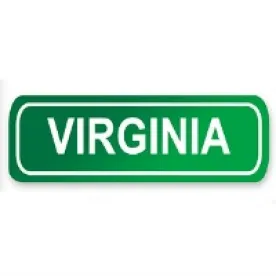As we previously reported, Virginia became the first state to issue mandatory COVID-19 workplace safety rules when the Virginia Safety and Health Codes Board (“VSHCB”) approved an emergency temporary standard on July 15, 2020. The final text has now been released and the new rules, which apply to most private employers, went into effect July 27, 2020. Employers who fail to comply may be subject to fines of up to $13,494 for a “serious” violation and up to $134,937 for a “repeat” or “willful” violation.
Key Takeaways
Virginia’s new rules are quite detailed. The new mandatory workplace rules will: prohibit workers or other individuals suspected of having coronavirus from coming to the workplace; require employers to comply with certain types of protocols when allowing recovered workers to return to the workplace; and mandate the use of personal protective equipment (“PPE”), disinfection and sanitation, social distancing, employee training, and infectious disease response plans under certain circumstances. In workplaces deemed to be at “lower” risk exposure, employees will be required to wear cloth face coverings when they are unable to maintain six feet of distance, and workplaces that are deemed to have “very high,” “high,” or “medium” risk exposure will have additional workplace requirements.
More Details
On Wednesday, July 15, 2020 the VSHCB adopted § 16 VAC 25-220, Emergency Temporary Standard, Infectious Disease Prevention: SARS-CoV-2 Virus That Causes COVID-19 (the “ETS”).
Effective Date
The ETS took immediate effect on July 27, 2020, the date it was published in a Richmond newspaper in accordance with Virginia law. However, according to the Virginia Department of Labor and Industry’s news release, the requirement for certain workplaces to have a written infectious disease preparedness and response plan and the training component related to such plans will take effect sixty (60) days after the ETS effective date, on September 25, 2020, and all other training requirements will take effect thirty (30) days after the ETS effective date, on August 26, 2020.
The temporary standard will remain in effect for six months and then will automatically expire unless it’s replaced by a permanent regulation.
Employers Affected
The ETS will apply to employers in the Commonwealth of Virginia that fall within Virginia Occupational Safety and Health (“VOSH”) jurisdiction as described in §§ 16VAC25-60-20 and 16VAC25-60-30, which includes most private employers in Virginia, as well as all state and local employees. However, private and public institutions of higher education are deemed to be in compliance if they have re-opening plans certified by the State Council of Higher Education in Virginia and are acting in compliance with those plans as long as those plans provide equivalent or greater levels of employee protection than the ETS provision.
The Emergency Temporary Standard Requirements
A. Interaction with CDC Guidelines
Employers that comply with recommendations contained in Center for Disease Control (“CDC”) guidelines to reduce the risk of COVID-19 in the workplace that provide equivalent or greater protection than provided by a provision in the ETS will be considered to be in compliance with the standard. And complying with such recommendations, mandatory or non-mandatory, will be considered evidence of good faith in any enforcement proceeding related to the ETS.
B. Requirements Differ Depending on Level of Risk Exposure
The ETS’s requirements differ depending on whether the hazard or job task falls under the standard’s definition of “very high,” “high,” “medium,” or “lower” exposure risk levels. Determining exposure risk levels includes consideration of the job tasks being undertaken, the work environment (e.g., indoors or outdoors), the ability to practice physical distancing, the types of transmission exposure that may be encountered such as potential exposure to airborne transmission or contact with contaminated surfaces, and the presence of an individual known or suspected to be infected with the SARS-CoV-2 virus, the virus that causes COVID-19.
C. Mandatory Requirements for All Employers
No matter the level of exposure risk hazards – “very high,” “high,” “medium,” or “lower” exposure risk – the ETS imposes several mandatory requirements for all Virginia employers. Employers are required to:
-
Conduct a hazard risk assessment for hazards and job tasks that may potentially expose employees to COVID-19 and to classify each job task according to the standard’s “very high,” “high,” “medium,” or “lower” exposure risk.
-
Enable employees to have “easy, frequent access, and permission to use soap and water, and hand sanitizer where feasible, for the duration of work.”
-
Provide flexible sick leave policies consistent with public health guidance “to the extent feasible and permitted by law, including but not limited to the Families First Coronavirus Response Act.”
-
Encourage employees to “self-monitor for signs and symptoms of COVID-19” and “inform employees of the methods of” self-monitoring.
-
“Develop and implement policies and procedures for employees to report when they are experiencing symptoms consistent with COVID-19 and no alternative diagnosis has been made.”
-
Not permit employees or other individuals known or suspected to be infected with the virus “to report to or remain at the work site or engage in work at a customer or client location until cleared for return to work” as outlined in the ETS. Workers known or suspected to have the virus may still engage in telework or other forms of work isolation.
-
Communicate with subcontractors and companies that provide contract or temporary employees about “the importance of employees or other persons” known or suspected to have the virus staying home.
-
“To the extent permitted by law, including HIPAA, establish a system to receive reports” to track and communicate when employees, subcontractors, contract employees, and temporary employees test positive for COVID-19 and have been present in the workplace within the previous 14 days of the positive test. Employers must notify:
-
“Its own employees who may have been exposed, within 24 hours of becoming aware of their possible exposure,” while keeping the identity of the individual who tested positive confidential in accordance with federal and Virginia laws and regulations. Employers must make similar notifications to other employers whose employees were present at the worksite and may have been exposed during that time period as well as to the building/facility owner.
-
The Virginia Department of Health within 24 hours of the discovery of a positive case; and
-
The Virginia Department of Labor and Industry “within 24 hours of the discovery of three (3) or more employees present at the place of employment within a 14-day period testing positive for [COVID-19] during that 14-day time period.”
-
-
“Nothing in the standard shall be construed to require employers to conduct contact tracing.”
-
Develop and implement policies and procedures for employees to return to work after they are known or suspected to have had COVID-19. The standard requires employers to use either a symptom-based or test-based strategy when making return to work determinations. Employers may not use antibody testing, or serological testing, to make return to work decisions.
-
Under a symptom-based strategy, an employee would not be allowed to return to work until 10 days have passed since symptom onset and 3 days (72 hours) have passed since recovery (e.g. resolution of fever without the use of fever-reducing medication and improvement in respiratory symptoms such as coughing or shortness of breath).
-
Under a test-based strategy, an employee would not be allowed to return to work until resolution of fever without use of fever-reducing medications, improvement in respiratory symptoms, and at least two negative COVID-19 test results that comply with certain standards.
-
Additionally, the standard states that COVID-19 testing is considered a “medical examination” under VA Code § 40.1-28 and thus, the employee cannot be required to pay for the cost of the test for return to work determinations.
-
-
Develop policies and procedures for asymptomatic employees to return to work either through a time-based or test-based strategy.
-
Under a time-based strategy, an employee who tested positive for COVID-19 but was asymptomatic would not be allowed to return to work until at least 10 days have passed since the date of their first positive COVID-19 diagnostic test.
-
Under a test-based strategy, an employee who tested positive for COVID-19 but was asymptomatic would not be allowed to return to work until they have had at least two negative COVID-19 test results that comply with certain standards.
-
-
“Ensure employees observe physical distancing while on the job and during paid breaks on the employer’s property” including through announcements, signage, visual cues, and staggering or restricting access to certain areas.
-
Control, reconfigure, and/or alternate access and usage to common areas, break rooms, and lunch rooms to ensure physical distancing. “If the nature of the employer’s work or work area does not allow employees to consume meals in the employee’s workspace while observing physical distancing,” the employer must clearly post occupancy limits, physical distancing requirements, and policies on hand washing/sanitizing and surface disinfection at the entrance to the area. Employers must also “enforce the occupancy limit,” make “hand washing facilities, and hand sanitizer where feasible,” available to employees, and provide regular intervals of cleaning or disinfecting or require employees to clean and disinfect the immediate area in which they were located prior to leaving.
-
When “the nature of the employee’s work or the work area does not allow employees to observe physical distancing requirements” or “when engineering, work practice, and administrative controls are not feasible or do not provide sufficient protection,” employers shall provide personal protective equipment (“PPE”) and ensure compliance with respiratory protection and PPE standards “applicable to its industry” and “in accordance with VOSH laws, standards, and regulations.”
-
The ETS also includes requirements relating to sanitation and disinfection, including requirements to clean and disinfect areas where individuals known or suspected to have COVID-19 accessed or worked, cleaning and disinfecting frequently touched surfaces and doors at the end of each shift, providing employees who interact with the general public, customers, or contractors with supplies to immediately clean and disinfect surfaces contacted during the interaction, and ensuring use of only EPA-approved disinfecting chemicals and products for use against COVID-19.
D. Heightened Requirements for “Medium,” “High,” and “Very High” Risk Workplaces
The ETS additionally includes heightened requirements for workplaces with hazards or job tasks classified as “medium” exposure risk. Such requirements include engineering controls such as appropriate maintenance and compliance of air-handling systems, and administrative and work practice controls “to the extent feasible” such as requiring a prescreening of symptoms prior to work shifts, implementing telework and/or staggered shift policies, and installing physical barriers to aid in mitigating the spread of COVID-19. The FAQs published on July 27, 2020 clarify that the ETS does not require these employers install air conditioning systems as the requirement “specifically applies to ‘air-handling systems where installed.’” The ETS additionally states employers must assess the workplace to determine if COVID-19 hazards or job tasks are present or are likely to be present that necessitate the use of PPE. If such hazards exist, employers must select and provide appropriate PPE to affected employees. Employers must also verify in a written certification that the required workplace hazard assessment to identify appropriate PPE has been performed.
Further requirements are established for hazards or job tasks classified as “very high” or “high” exposure risk, including installing appropriate air-handling systems, using airborne infection isolation rooms “where feasible and available”, limiting the amount of time workers are in contact with patients who are known or suspected to have COVID-19, offering enhanced medical monitoring of employees during COVID-19 outbreaks, and providing employees with job-specific education and training on preventing transmission of COVID-19. The ETS further states that “to the extent feasible,” employers should ensure psychological and behavioral support is available to address employee stress at no cost to the employee.
Employers with hazards or job tasks classified as “medium” risk exposure with eleven (11) or more employees, or those with hazards or jobs tasks classified as “high,” or “very high” risk exposure are required to develop and implement a written Infectious Disease and Preparedness Response Plan (the “Plan”). This requirement will come into effect sixty (60) after the effective date of the ETS, on September 25, 2020. Covered employers must designate a person to be responsible for implementing the Plan and the Plan must provide for employee involvement in its development and implementation. The Plan must consider and address the COVID-19 risk hazards in the workplace, employees’ individual risk factors, contingency plans for situations arising from COVID-19 outbreaks, implementation of basic infection prevention measures, as well as policies for prompt identification and isolation of individuals in the workplace who are known or suspected to be infected with COVID-19. Additionally, if the employer is complying with mandatory and non-mandatory recommendations in any CDC guidelines or Commonwealth of Virginia guidance documents in lieu of complying with an ETS provision, the Plan must identify such materials.
Employers with hazards or job tasks classified as “medium,” “high,” or “very high” exposure risk must provide training to all employees working at the worksite to recognize the hazards of the virus and signs and symptoms of COVID-19 disease as well as train employees on procedures to follow to minimize these hazards. This requirement will come into effect thirty (30) days after the effective date of the ETS, on August 26, 2020, and is required for all employees at the worksite regardless of that employee’s specific risk classification. The training should include the ETS requirements, CDC mandatory and non-mandatory recommendations, work practices to minimize the risks and hazards associated with COVID-19, PPE use and limitations, the anti-discrimination provisions of the ETS, and the employer’s Plan where applicable. Training regarding the employer’s Plan must be implemented by September 25, 2020, sixty (60) after the effective date of the ETS. Employers must additionally verify compliance with this standard by having employees exposed to “medium,” “high,” or “very high” exposure risk hazards or job tasks sign a written certification that identifies the employee trained, the details of the training, and the name of the person(s) who prepared the training materials and conducted the training. Retraining must be provided when the employer has reason to believe the employee does not have the understanding or skill required under the ETS, when changes in the workplace render prior training obsolete, or when changes are made to the employer’s Plan.
Instead of training, employers with hazards or job tasks classified at “lower” risk may provide written or oral information to employees regarding the ETS requirements, the characteristics of the virus, work practices aimed at minimizing the risk of spreading the virus, and the anti-discrimination provision of the ETS. The VDLI has provided an information sheet that can be used to comply with this requirement.
E. Whistleblower Protection
The ETS also includes a prohibition on “discharg[ing] or in any way discriminat[ing] against an employee for exercising rights under the safety and health provisions of [the ETS]” or against an employee who raises a “reasonable concern” about COVID-19 infection control in the workplace to the employer, employer’s agent, other employees, a government agency, or to the public through print, online, social, or any other media.
Interpretive Materials
The VOSH Cooperative Programs Division released training and outreach materials including “Nine Steps to Achieve COVID-19 ETS Compliance,” a Hazard Assessment Certification document, a PowerPoint on the ETS requirements, FAQs about the standard, an Infectious Disease Preparedness and Response Plan Template for different industries including specific guidance for research laboratories, retail stores, and offices, and a training information sheet for employers with hazards or job tasks classified as “lower” risk. The Virginia Department of Labor and Industry’s July 27 news release additionally stated that the department offers On-Site Consultation Services to help employers better understand and voluntarily comply with VOSH standards.
Conclusion
Virginia is the first state to make workplace safety rules around potential COVID-19 risk exposure mandatory. Employers in the Commonwealth of Virginia should consult these new rules and assess whether to adjust workplace policies, procedures, and physical arrangements to come into compliance and avoid the risk of fines.




 />i
/>i

